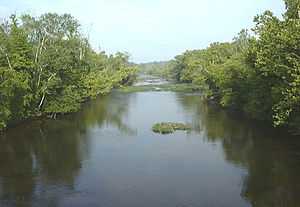Appomattox River
| Appomattox River | |
| River | |
 The Appomattox River at Matoaca, Virginia | |
| Country | United States |
|---|---|
| State | Virginia |
| Cities | Petersburg, Tri-cities |
| Source | |
| - elevation | 820 ft (250 m) [1] |
| - coordinates | 37°24′1″N 78°49′14″W / 37.40028°N 78.82056°W [2] |
| Mouth | James River |
| - elevation | 0 ft (0 m) [1] |
| - coordinates | 37°19′15″N 77°16′32″W / 37.32083°N 77.27556°WCoordinates: 37°19′15″N 77°16′32″W / 37.32083°N 77.27556°W [2] |
| Length | 157 mi (253 km) [2] |
| Basin | 1,344 sq mi (3,481 km2) [3] |
| Discharge | for Matoaca |
| - average | 1,366 cu ft/s (39 m3/s) [3] |
| - max | 39,400 cu ft/s (1,116 m3/s) |
| - min | 18 cu ft/s (1 m3/s) |
 Map of the James River watershed with the Appomattox River watershed highlighted light yellow; the Appomattox River is shown in dark blue
| |
The Appomattox River is a tributary of the James River, approximately 157 miles (253 km) long,[4] in central and eastern Virginia in the United States, named for the Appomattocs Indian tribe who lived along its lower banks in the 17th century. It drains a cotton and tobacco-growing region of the Piedmont and coastal plain southwest of Richmond.
The English colonists in Virginia at first tried to rename the Appomattox as the "Bristoll River", however this name did not catch on, while the native one did. There are numerous historical spelling variants, such as Apamatuck, Apamutiky, Appamattuck, Appomattake, and Apumetecs, among others.
Course
The Appomattox River rises in the Piedmont of northeastern Appomattox County, approximately 10 miles (16 km) northeast of the town of Appomattox. It flows generally southeast through the Appomattox-Buckingham State Forest to Farmville. From Farmville it flows in a large arc northeast then southeast across the coastal plain, passing southwest of Richmond and passing through the Lake Chesdin reservoir. It flows through Petersburg, its head of navigation, through the Tri-cities area, then joins the James River from the west at City Point in Hopewell.
History
In April 1865 during the Appomattox Campaign of the American Civil War, the Confederate forces attempted to burn the High Bridge over the river northwest of Burkeville in order to escape the pursuing Union Army after the fall of Petersburg. The Union capture of the bridge was a contributing factor in the forcing of General Robert E. Lee's surrender at nearby Appomattox Court House, ending the war in Virginia.
Recreation
The river is a popular destination for whitewater rafting and canoeing, particularly down stream of the small Abutment Dam (which is itself only a couple miles down stream of Chesdin Dam) in the village of Matoaca to Petersburg near Virginia State University.
See also
- List of Virginia rivers
References
- ↑ 1.0 1.1 Google Earth elevation for GNIS coordinates.
- ↑ 2.0 2.1 2.2 U.S. Geological Survey Geographic Names Information System: Appomattox River
- ↑ 3.0 3.1 James River Basin, from Water Resources Data Virginia Water Year 2005, USGS.
- ↑ U.S. Geological Survey. National Hydrography Dataset high-resolution flowline data. The National Map, accessed April 1, 2011